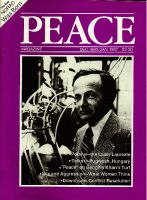
Peace Magazine Dec 1986-Jan 1987, page 5. Some rights reserved.
Search for other articles by Leigh Edwards here
The Great Peace March for Global Nuclear Disarmament is alive and well ??????- and making its way across the United States. For a long time, most American media and the rest of the world
had believed that the march had died somewhere outside Barstow, California. It is true that the Pro-peace Peace March did fail, but out went the old and in came the new--"Great Peace March."
Pro-peace was the creative dream of Californian David Mixner, once a campaign manager for Gary Hart. Originally there were 1500 people; approximately thirty from ten other countries, five Canadians, and the rest, U.S. citizens. We had left our families, jobs, responsibilities, and obligations for nine months of our lives to walk across the U.S.A. Two days before the march was to depart from Los Angeles, Mixner came to our campsite to inform us that there were suddenly serious problems with insurance costs for campsites, and for those marchers who had signed with a particular health insurance plan. A few people, including doctors and some other Pro-peace staff, left the march at the first sign of trouble.
The march continued, despite the blow. Two weeks later, we were in an area just outside Barstow, California when another blow came. Mixner flew in by helicopter to tell the camp that the Pro-peace march was near bankruptcy and had little chance of surviving. Sponsors pulled out and many marchers left to go home. We watched as the repo-man came and took our life-system away--transportation vehicles, portable toilets, kitchen equipment, and even the kitchen itself. But the 350 marchers who remained used every effort to make sure we were not completely stranded. Two weeks later, through sheer determination, the new march was created.
This new march is far more grassroots than the original Pro-Peace march--it's very political, and with a defined statement of purpose. We are an abolitionist movement in favor of a Comprehensive Test Ban Treaty, a global freeze, reductions of the nuclear arsenals, and a ban on the militarization of space. We have walked through ten states, speaking in churches, schools, and state capitals, and staging peace rallies in major cities on our route: L.A., Denver, Lincoln, Salt Lake City, Iowa
City, Chicago, Cleveland. As this magazine reaches its subscribers, the march will be complete. We expect to reach New York on October 23rd and finally Washington on November 15. We have asked people to join us for one week, one day, or all the way. Since Chicago, the march has been 700-people strong, and it is growing daily. A rally of thousands is planned for Washington. Many people who would not have supported the major media event that Pro-peace had become have supported the Great Peace March--financially, physically, or spiritually.
The march is funded by private donations, including major sums that have come from some well-known, committed peace activists: Yoko Ono, Paul Newman, Emilio Estevez, to name a few. Smaller donations have provided the backbone of support for the march. Our supporters include Physicians for Social Responsibility, veterans, and children. Among the people who have walked with us and stayed with us in." Peace City" are Ram Dass, Holly Near, Pete Seeger, and Allen Ginsberg.
We international marchers have seen the military machine that before we had merely heard about. It has made us more determined to thwart the mad nuclear arms race. A classical example of the insanity was on the gates of a SAC Air Force base. The motto on the base is "Peace is Our Profession." F-111s flew over our heads for several days in the "peaceful" Mojave desert. We have seen missile silos in almost every state through which we walked. We stood at the gates of the Nevada test site the day the U.S. responded with a new test to the USSR test moratorium. Few Canadians can realize the true extent of the U.S. military machine. To spend nine months among Americans and listen to their views on peace is very shocking. On the positive side, the cultural exchange has been rewarding. For the marchers from the other ten countries it has given us a chance to discuss with the Americans the steps toward the abolition or reduction of nuclear weapons. Many people who have supported us, such as the farmers and steel workers, feel that the government is currently spending too much on the military. Their support is deeply heartening. This is not quick or easy. But it has been worth every step my tired feet have taken.

Peace Magazine Dec 1986-Jan 1987, page 5. Some rights reserved.
Search for other articles by Leigh Edwards here